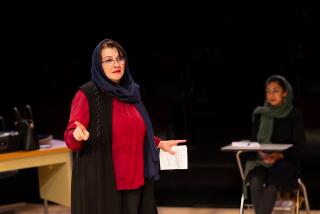Lack of Context Limits Persian Program
- Share via
Midway through a performance by his Avaz International Dance Theatre on Saturday, company founder and co-director Anthony Shay spoke of how the events of Sept. 11 had refocused his sense of mission. Programs such as this one, he said, “might lessen the unknown quality of our Middle Eastern immigrants” and foster increased understanding.
Pious words, but, unfortunately, programs such as this one, with extensive songs and speeches in Persian and dances on such arcane subjects as Persian Gulf exorcism, foster negligible crossover interest and merely confirm Avaz’s status as an expression of the local Iranian American community’s cultural legacy.
Shay needs to spend much less time in the spotlight lapping up applause and far more effort enlisting the Islamic community as a whole in projects that illuminate the beliefs and traditions of a complex, misunderstood religion.
The performance at the Japan America Theatre on Saturday offered skillful dancing, sophisticated choreography and vibrant musicianship, plus costume splendors galore. But as usual for Avaz, it mostly detailed how things looked and sounded at a certain time and place in the Iranian (a.k.a. Persian) world.
Shay’s sextet “Savaran,” for instance, evoked 13th century women’s court dances in circular and serpentine formations ornamented with exceptionally delicate hand motion: airy brushings as well as sharp swings by both hands to the left or right followed by turns with arms held overhead.
However, the intricately embellished dancing and the equally detailed costumes by co-director Jamal looked misplaced throughout the program against barren color-washes on the cyclorama.
No selection suffered more from the lack of scenic context than Jamal and Shay’s “Summer Nights in the Alhambra,” a suite inspired by Granada’s fabled Islamic palace, to music by M. Nejad. Cultural diversity ruled here, and though it proved impossible to guess where this work in progress might be heading, the component dances and costumes were often stunningly beautiful.
A revised version of Jamal’s powerful, ritualistic “Charkh: Turning Through Time” minimized the antique poetry formerly prominent but still found it difficult to sustain movement flow through the stop-and-go passages of Hosein Alizadeth’s score.
The final section, however, adroitly set brief corps excursions against the nonstop, accelerating, dervish-style whirling of Karen Ochoa.
Shay’s two song-sets featured brilliant accompaniment by Siyamak Pouian on drum and Nejad on flute, tambourine and dulcimer.
More to Read
The biggest entertainment stories
Get our big stories about Hollywood, film, television, music, arts, culture and more right in your inbox as soon as they publish.
You may occasionally receive promotional content from the Los Angeles Times.










